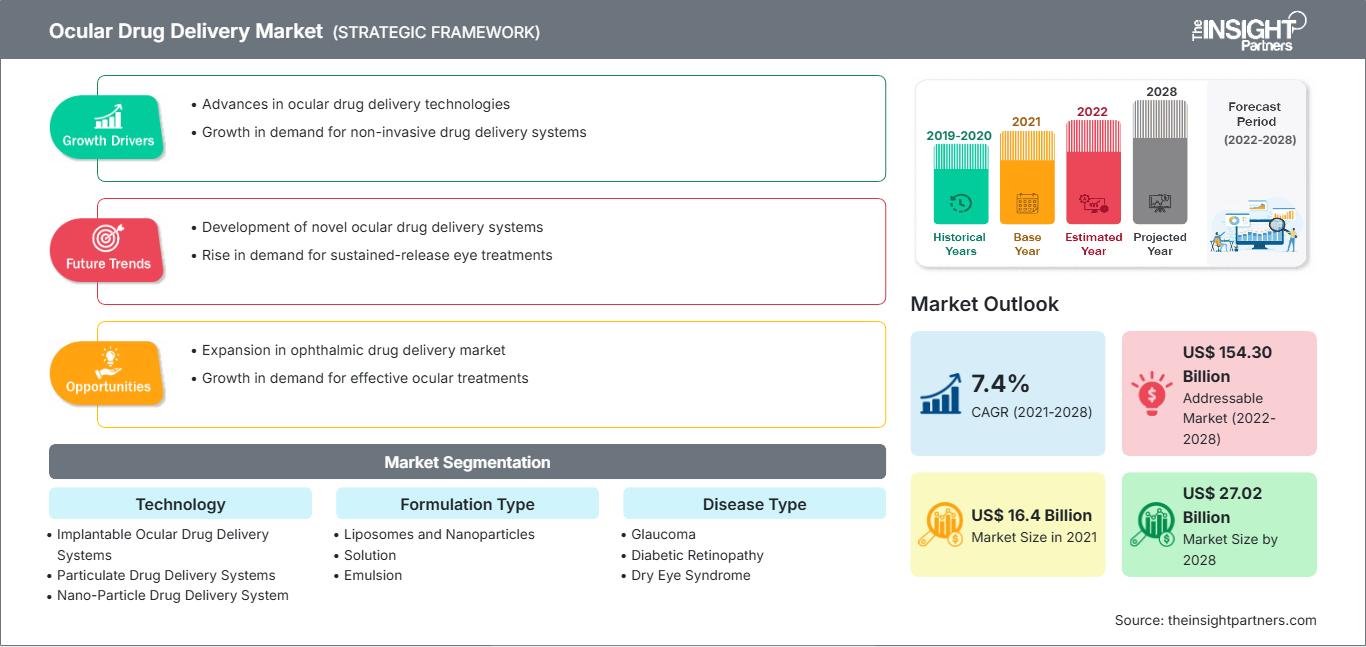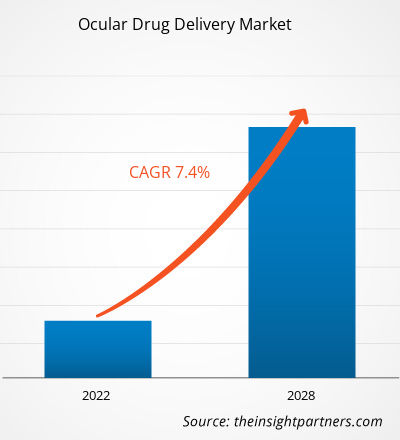Ocular Drug Delivery Market Growth Opportunities and Forecast by 2028
Historic Data: 2019-2020 | Base Year: 2021 | Forecast Period: 2022-2028Ocular Drug Delivery Market Forecast to 2028 - COVID-19 Impact and Global Analysis By Technology (Implantable Ocular Drug Delivery Systems, Particulate Drug Delivery Systems, Nano-Particle Drug Delivery System, and Others), Formulation Type (Liposomes and Nanoparticles, Solution, Emulsion, Suspension, and Ointment), Disease Type (Glaucoma, Diabetic Retinopathy, Dry Eye Syndrome, Macular Degeneration, Cataract, Diabetic Macular Edema, and Others), and End User (Hospitals, Ophthalmic Clinics, and Ambulatory Surgical Centers) and Geography
- Report Date : Sep 2021
- Report Code : TIPRE00004206
- Category : Life Sciences
- Status : Published
- Available Report Formats :


- No. of Pages : 171
The ocular drug delivery market was valued at US$ 16,404.32 million in 2021 and is projected to reach US$ 27,016.20 million by 2028; it is expected to grow at a CAGR of 7.4 % from 2021 to 2028.
An ocular drug delivery system (ODDS) is a dosage form, vehicle, or system intended to instill, administer, or deliver drug/medicine to the eye against any ailment or disorder involving or affecting vision. It ranges from simple sterile eye drop for the ocular surface to complex implants for intraocular tissue. Ocular drug formulations are primarily liquid forms, such as solutions, suspensions, and emulsions for treating anterior eye segment diseases. These formulations can be available in the form of advanced drug delivery systems like in-situ gel, microemulsion, nanoparticle, liposome, iontophoresis, nanosuspension, and ocular inserts.
The ocular drug delivery market has been segmented based on technology, formulation type, disease type, end user, and geography. By geography, the market is primarily segmented into North America, Europe, Asia Pacific, the Middle East & Africa, and South & Central America. The report offers insights and in-depth analysis of the ocular drug delivery market, emphasizing parameters such as market trends, technological advancements, and market dynamics, along with competitive landscape analysis of the globally leading market players.
Customize This Report To Suit Your Requirement
You will get customization on any report - free of charge - including parts of this report, or country-level analysis, Excel Data pack, as well as avail great offers and discounts for start-ups & universities
Ocular Drug Delivery Market: Strategic Insights

-
Get Top Key Market Trends of this report.This FREE sample will include data analysis, ranging from market trends to estimates and forecasts.
Market Insights
Growing Prevalence of Eye Disorders to Boost Ocular Drug Delivery Market Growth
The leading cause of blindness or low vision across the globe is cataract, glaucoma, age-related macular degeneration, diabetic retinopathy, and unaddressed refractive error. The majority of the global population have or had some eye disorder in their lifetime. As per the World Health Organization (WHO) report “Blindness and vision impairment” published in February 2021, around 2.2 billion people worldwide have a near or distance vision impairment. It has also estimated that the leading cause of vision loss or low vision is cataract (94 million) and uncorrected refractive errors (88.4 million). Further, the other common causes of vision loss are glaucoma (7.7 million), corneal opacities (4.2 million), diabetic retinopathy (3.9 million), and trachoma (2 million).
According to the National Eye Institute (NEI), in the US, the number of people with cataracts is expected to double from 24.4 million in 2010 to about 50 million in 2050. Similarly, as per the Factsheet Glaucoma: Facts & Figures 2019, over 3 million people in the US were living with glaucoma. Moreover, as per the Canadian Survey on Disabilities 2017, 1.5 million Canadians had a sight loss, and around 5.59 million had an eye disease which could further lead to sight loss.
Additionally, as per the Royal National Institute of Blind People in 2017, in the UK, there were around 350,000 people registered as blind and partially sighted; about 173,735 were registered for severely sight impaired; and 176,125 were registered for sight-impaired.
Technology-Based Insights
Based on technology, the ocular drug delivery market is segmented into implantable ocular drug delivery systems, particulate drug delivery systems, nano-particle drug delivery system, and others. The implantable ocular drug delivery systems segment would account for the largest market share in 2021, and the same segment is anticipated to register the highest CAGR during the forecast period.
Formulation Type-Based Insights
Based on formulation type, the ocular drug delivery market is segmented into liposomes and nanoparticles, solution, emulsion, suspension, and ointment. The solution segment would hold the largest share of the market in 2021, and it is estimated to register the highest CAGR in the market during 2021–2028. The growth of the solution segment is attributed to the increasing adoption of ocular drug delivery systems in solution forms, like eye drops and injectables.
Disease Type–Based Insights
Based on disease type, the ocular drug delivery market is segmented into glaucoma, diabetic retinopathy, dry eye syndrome, macular degeneration, cataract, diabetic macular edema, and others. The cataract segment would account for the largest market share in 2021. The market for this segment is estimated to grow at the highest CAGR from 2021 to 2028.
End User–Based Insights
Based on end user, the ocular drug delivery market is segmented into hospitals, ophthalmic clinics, and ambulatory surgical centers. The hospitals segment would hold the largest share of the market in 2021, while the ophthalmic clinics segment is estimated to register the highest CAGR in the market during the forecast period.
The COVID-19 pandemic has become the most significant challenge across the world. As this pandemic has stressed healthcare systems across the globe, prioritizing the limited resources was essential to minimize hospital admissions. However, despite increased demand for ocular therapeutics such as eye drops, ointment, and suspension, there was a shortage of these products as new consumers entered the market. Manufacturers are also experiencing raised prices and potential shortages of raw ingredients due to supply restrictions. However, as the restrictions have been lifted and businesses are resuming, the demand-supply variables are coming back to normal. This will offer several growth prospects for ocular drug delivery therapeutics.
Acquisitions, collaborations, partnerships, product launches, and expansions are commonly adopted strategies by companies to expand their footprint worldwide and meet the growing demand. The ocular drug delivery market players have been chiefly adopting the strategy of product innovation to cater to the changing customer demand across the world, which also helps them maintain their brand name globally.
Ocular Drug Delivery Market Regional InsightsThe regional trends and factors influencing the Ocular Drug Delivery Market throughout the forecast period have been thoroughly explained by the analysts at The Insight Partners. This section also discusses Ocular Drug Delivery Market segments and geography across North America, Europe, Asia Pacific, Middle East and Africa, and South and Central America.
Ocular Drug Delivery Market Report Scope
| Report Attribute | Details |
|---|---|
| Market size in 2021 | US$ 16.4 Billion |
| Market Size by 2028 | US$ 27.02 Billion |
| Global CAGR (2021 - 2028) | 7.4% |
| Historical Data | 2019-2020 |
| Forecast period | 2022-2028 |
| Segments Covered |
By Technology
|
| Regions and Countries Covered |
North America
|
| Market leaders and key company profiles |
|
Ocular Drug Delivery Market Players Density: Understanding Its Impact on Business Dynamics
The Ocular Drug Delivery Market is growing rapidly, driven by increasing end-user demand due to factors such as evolving consumer preferences, technological advancements, and greater awareness of the product's benefits. As demand rises, businesses are expanding their offerings, innovating to meet consumer needs, and capitalizing on emerging trends, which further fuels market growth.

- Get the Ocular Drug Delivery Market top key players overview
Company Profiles
- AbbVie Inc.
- Bausch Health Companies Inc.
- Taiwan Liposome Company, Ltd.
- Ocular Therapeutix, Inc.
- GRAYBUG VISION, INC.
- Alimera Sciences, Inc.
- Envisia Therapeutics
- Novartis AG
- EYEGATE PHARMACEUTICALS, INC
- Clearside Biomedical, Inc.
Frequently Asked Questions
What are the challenges hindering the adoption of Ocular drug delivery?
Who are the major players in the Ocular drug delivery market?
What are the driving factors for the Ocular drug delivery market across the globe?
What is ocular drug delivery?
Mrinal is a seasoned research analyst with over 8 years of experience in Life Sciences Market Intelligence and Consulting. With a strategic mindset and unwavering commitment to excellence, she has built deep expertise in pharmaceutical forecasting, market opportunity assessment, and developing industry benchmarks. Her work is anchored in delivering actionable insights that empower clients to make informed strategic decisions.
Mrinal’s core strength lies in translating complex quantitative datasets into meaningful business intelligence. Her analytical acumen is instrumental in shaping go-to-market (GTM) strategies and uncovering growth opportunities across the pharmaceutical and medical device sectors. As a trusted consultant, she consistently focuses on streamlining workflow processes and establishing best practices, thereby driving innovation and operational efficiency for her clients.
- Historical Analysis (2 Years), Base Year, Forecast (7 Years) with CAGR
- PEST and SWOT Analysis
- Market Size Value / Volume - Global, Regional, Country
- Industry and Competitive Landscape
- Excel Dataset
Related Reports
Testimonials
The Insight Partners' SCADA System Market report is comprehensive, with valuable insights on current trends and future forecasts. The team was highly professional, responsive, and supportive throughout. We are very satisfied and highly recommend their services.
RAN KEDEM Partner, Reali Technologies LTDsI requested a report on a very specific software market and the team produced the report in a few days. The information was very relevant and well presented. I then requested some changes and additions to the report. The team was again very responsive and I got the final report in less than a week.
JEAN-HERVE JENN Chairman, Future AnalyticaWe worked with The Insight Partners for an important market study and forecast. They gave us clear insights into opportunities and risks, which helped shape our plans. Their research was easy to use and based on solid data. It helped us make smart, confident decisions. We highly recommend them.
PIYUSH NAGPAL Sr. Vice President, High Beam GlobalThe Insight Partners delivered insightful, well-structured market research with strong domain expertise. Their team was professional and responsive throughout. The user-friendly website made accessing industry reports seamless. We highly recommend them for reliable, high-quality research services
YUKIHIKO ADACHI CEO, Deep Blue, LLC.This is the first time I have purchased a market report from The Insight Partners.While I was unsure at first, I visited their web site and felt more comfortable to take the risk and purchase a market report.I am completely satisfied with the quality of the report and customer service. I had several questions and comments with the initial report, but after a couple of dialogs over email with their analyst I believe I have a report that I can use as input to our strategic planning process.Thank you so much for taking the extra time and making this a positive experience.I will definitely recommend your service to others and you will be my first call when we need further market data.
JOHN SUZUKI President and Chief Executive Officer, Board Director, BK TechnologiesI wish to appreciate your support and the professionalism you displayed in the course of attending to my request for information regarding to infectious disease IVD market in Nigeria. I appreciate your patience, your guidance, and the fact that you were willing to offer a discount, which eventually made it possible for us to close a deal. I look forward to engaging The Insight Partners in the future, all thanks to the impression you have created in me as a result of this first encounter.
DR CHIJIOKE ONYIA MANAGING DIRECTOR, PineCrest Healthcare Ltd.Reason to Buy
- Informed Decision-Making
- Understanding Market Dynamics
- Competitive Analysis
- Identifying Emerging Markets
- Customer Insights
- Market Forecasts
- Risk Mitigation
- Boosting Operational Efficiency
- Strategic Planning
- Investment Justification
- Tracking Industry Innovations
- Aligning with Regulatory Trends




















 Get Free Sample For
Get Free Sample For